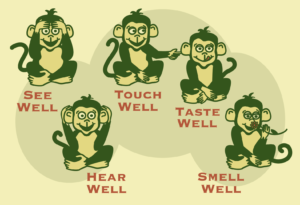The five senses help us experience and behold the world. Tapping into our sensory experiences can also be a powerful way to write more creatively and connect more directly with readers. Try these exercises to help you connect with your senses. While doing the exercises, it will be helpful to have a writing journal or recorder nearby so you can capture your thoughts and feelings more easily.
- Of the five senses, what is your strongest sense? What is your weakest or most underdeveloped sense? To pique your weakest sense, write down five intense sensations or experiences that would enliven that sense. What words or descriptions come to mind to describe those heightened experiences?
- Has something you've seen or heard brought you to tears? How about something you've smelled? Or tasted? Describe your experiences.
- Words carry emotion, melody, and rhythm—sometimes contrary to their actual meaning. Listen to the following words and write about the types of music, sensations, and feelings they convey or evoke: cataclysmic, resplendent, muddled, precipitous, swirling, cacophony, succulent.
- Find an exotic fruit or vegetable that you have never tasted before and write about your first experience of tasting it. What places, emotions, and memories does eating it invoke?
- Build a poem or some prose using the following instructions:
o What are the object’s strengths and weaknesses?
o Describe what is true about the object.
o What is unknowable, indescribable, or hidden about the object?
o Have a character interact with the object and tell you what it means to him/her.
o What would happen if the object became lost or destroyed?
o How can the object be transformed into something else?
- Describe an outdoor scene using only your sense of smell or taste. What emotions and memories do these smells and tastes trigger?
- In synesthesia, one sense can trigger another. For example, a sound can trigger certain colors, or certain words can trigger specific tastes or smells. Have you ever had experiences like these? During your day, observe how your senses overlap, bend, and expand. See if you can extend your awareness of your sensory experiences beyond your normal perception. Can you hear grass, smell sunlight, taste wind, etc.?
- Describe how you feel when you unexpectedly get caught in a rainstorm, windstorm, or snowstorm.
- Describe what you are feeling right now using only a whisper.
- Politely eavesdrop on a conversation and listen to the kinds of words and expressions the people use. What tone and volume do they use? Is one person dominating the conversation? How do the others respond? What words describe their interaction? See if you can imagine and describe their facial expressions and gestures without looking at them.
From Thesaurus of the Senses, a tool for writers, poets, teachers, students, and word lovers, written by Linda Hart. It is available on Amazon in paperback, Kindle ebook, and hardcover. Linda Hart is also the coauthor of Cat Grammar Guide.

